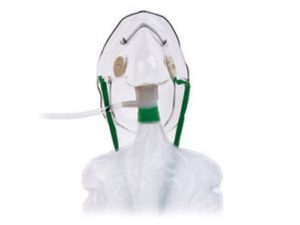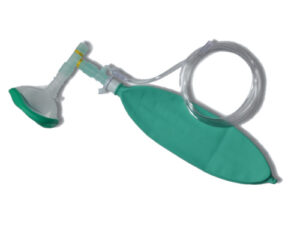In a perfect world, choosing the right oxygen mask would be a non-issue. Our oxygen suppliers would already understand cluster headache well enough to deliver the right equipment the first time. Unfortunately, this is often not the case. We must educate ourselves and advocate for our own health care needs.
There are several different types of oxygen delivery masks. While some cluster patients report getting relief from all of these, not all are created equal. Only three have clinical evidence to support their use for acute cluster attacks. Before you give up, thinking oxygen won’t work for you, make sure you’re using one of the three masks actually proven to work. Better yet, don’t give up until you’ve tried all three.
Nasal cannula
So you finally convince your doctor to prescribe oxygen and wait eagerly for that first delivery of sweet cluster ambrosia. You can barely contain your excitement until the delivery driver bursts your bubble by pulling out one of these. Give it a try if you’re desperate, but here’s why it’s not likely to work:
- you’re still breathing in room air, not pure oxygen
- you may also receive a concentrator (not a tank) or a regulator that limits the flow rate to 8 lpm or less
Face mask
If your oxygen supplier is a little better, you might get lucky enough to receive one of these. Again, it let’s in room air. Plus, you’re only going to inhale oxygen at the fixed flow rate.
Partial non-rebreather mask
Not even the pros can always tell the difference between this one and a true non-rebreather mask. They both have air reservoirs which should be allowed to fill up before placing the mask against your face. If you take a close look at the images, you’ll see that this one does not have valves covering the holes on each side of the mask. This allows room air to enter the mask, not giving you a good seal or pure oxygen.
Non-rebreather mask
AT MINIMUM, every cluster patient using oxygen should at least have one of these masks. The air reservoir allows you to breathe more deeply and inhale more oxygen with every breath. The valves covering the holes on the sides of the mask allow carbon dioxide to escape when you exhale without allowing room air to enter the mask. They’re so inexpensive that your oxygen supplier will give you several on request.
There are still two major drawbacks to this type of mask:
- It’s impossible to get a good seal around the face, so some room air will enter the mask.
- The air reservoir isn’t large enough for most of us. We breathe too deeply and flatten that little bag with every breath.
Cluster O2 Kit
This non-rebreather mask was designed specifically for cluster patients. The thick, cushioned padding on the mask allows an airtight seal for most people (sorry guys, but the beards are a problem). The air reservoir is much larger (and durable!) so most of us can take those deep breaths without flattening the bag. It also comes with a mouth tube for those who prefer to avoid the mask altogether. The retail price is $25 and can be ordered at Clusterheadaches.com.
Demand Valve
If you can’t part with that beard or continue to flatten the bag with each breath even with your regulator cranked up to 25 lpm, you might want to think about a demand valve. It gives you the option of a mouth tube or mask and delivers as much 100% pure oxygen as fast as you can inhale it with no wasted O2. It has only one down side. The price tag is often over $300. However, if insurance will cover it or you can sweet talk someone into the perfect gift, it’s a great idea.







